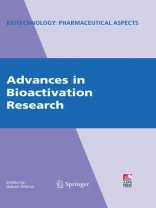I have always been interested in chemistry and biology. My undergraduate, graduate, and postdoctoral trainings in pharmacy, medicinal chemistry and pharmacology, respectively, have strengthened this interest and led me to realize that significant advances in medicine have frequently been realized because of research at the chem- try–biology interface. I am hoping that this comprehensive volume on recent advances in bioactivation research will stimulate pharmacologists, medicinal chemists, phar- ceutical scientists, and graduate students in these fields and related areas to consider and use bioactivation research when they explore and chart new frontiers in drug design and drug development and when they consider ways to reduce the side effects of existing drugs by making prodrugs. As for the toxicologists and environmental health scientists, I hope this volume will help them generate the knowledge needed to understand better mechanisms of toxicity to improve human risk assessments and intervention methods after occupational or environmental exposure to various hazardous chemicals. Adnan A. Elfarra, Ph. D. vii Part I General Concepts and Basic Mechanisms 1 Metabolic Concerns in Drug Design Jeffrey P. Jones Department of Chemistry, Washington State University, Pullman, WA 99164, USA e-mail: jpj@wsu. edu Keywords: Cytochrome P450 Aldehyde Oxidase Drug–Drug Interactions Mechanism-based Virtual Screening ADMET Regioselectivity 1. 1. Introduction Due to recent technological innovations, such as genomics, combinatorial chemistry, and high-throughput screening, the identification of disease targets and of compounds that are active against these targets (‘‘leads’’) can now be carried out efficiently.
Table of Content
General Concepts and Basic Mechanisms.- Metabolic Concerns in Drug Design.- Role of Bioactivation in Idiosyncratic Drug Toxicity: Structure#x2013;Toxicity Relationships.- Michael Addition#x2013;Elimination Reactions: Roles in Toxicity and Potential New Therapeutic Applications.- Induction of Drug-Metabolizing Enzymes: Contrasting Roles in Detoxification and Bioactivation of Drugs and Xenobiotics.- Mechanism-Based Inactivation of Cytochrome P450 2A and 2B Enzymes.- CYP2E1 #x2013; Biochemical and Toxicological Aspects and Role in Alcohol-Induced Liver Injury.- One- and Two-Electron-Mediated Reduction of Quinones: Enzymology and Toxicological Implications.- Lipoxidation-Derived Electrophiles as Biological Reactive Intermediates.- Bioactivation and Protein Modification Reactions of Unsaturated Aldehydes.- Tissue-Specific Features and Risk Assessment Applications.- Adaptive Responses and Signal Transduction Pathways in Chemically Induced Mitochondrial Dysfunction and Cell Death.- Hepatic Bioactivation and Drug-Induced Liver Injury.- Role of Cysteine S-Conjugate #x03B2;-Lyases in the Bioactivation of Renal Toxicants.- Bioactivation of Xenobiotics in Lung: Role of CYPs and FMOs.- Generation of Reactive Metabolites and Associated DNA Adducts from Benzene, Butadiene, and PAH in Bone Marrow. Their Effects on Hematopoiesis and Impact on Human Health.- Butadiene-Mediated Mutagenesis and Carcinogenesis.- Pharmacogenetics of Drug Bioactivation Pathways.- Human Phenanthrene Metabolites as Probes for the Metabolic Activation and Detoxification of Carcinogenic Polycyclic Aromatic Hydrocarbons.About the author
Dr. Elfarra received his B.S. degree in Pharmacy at Cairo University, Cairo, Egypt, in 1975 and his Ph.D. degree in Medicinal Chemistry at the University of Minnesota, Minneapolis, MN, in 1983. In 1985, Dr. Elfarra joined Shell Development Company in Houston, Texas as an associate research toxicologist after he completed his postdoctoral training in Pharmacology at the University of Rochester in Rochester, NY. Dr. Elfarra joined the University of Wisconsin-Madison as assistant professor in 1986. He was promoted to associate and full professor in 1992 and 1996, respectively. He served as the chair of the campus Biosafety Committee and has trained a large number of undergraduate students, graduate students, and postdoctoral students in his laboratory. He is the current director of the institutional training grant from NIEHS. Dr. Elfarra has served on the executive committee for the Division of Toxicology of the American Society for Pharmacology and Experimental Therapeutics, and has organized and participated in many national and international symposia focused on topics related to his research. He has served as consultant for many organizations, such as NIH, the National Research Council Board on Environmental Studies and Toxicology, the Health Effects Institute, Health Canada, and the International Agency for Research on Cancer.
Language English ● Format PDF ● Pages 503 ● ISBN 9780387773001 ● File size 7.3 MB ● Editor Adnan Elfarra ● Publisher Springer New York ● City NY ● Country US ● Published 2009 ● Downloadable 24 months ● Currency EUR ● ID 2146138 ● Copy protection Social DRM











